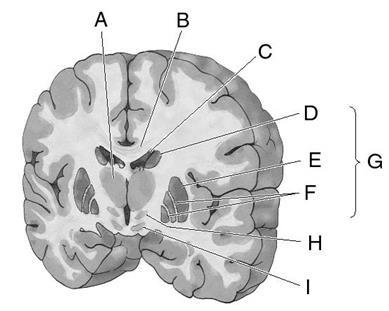Chapter 02: Multiple Choice
1. The cerebellum contains of all the neurons in the adult human brain.
a. 20 percent
b. 50 percent
c. 10 percent
d. 80 percent
ANSWER: d
2. Neural agenesis refers to:
a. an injury to a brain structure.
b. the degeneration of a structure.
c. the failure of a structure to develop.
d. the creation of a brain structure.
ANSWER: c
3. If a tree falls in the forest, does it make a sound if no one is present?
a. Yes, because sound is a physical phenomenon.
b. Yes, because if you record the noise and play it again later, you will hear it.
c. No, because sound is a fabrication of the human brain.
d. This is an unanswerable philosophical question.
ANSWER: c
4. Phenotypic plasticity refers to:
a. how an organism's genotype can be influenced by environmental factors.
b. how an organism's genetics can be influenced by its nervous system.
c. the study of nervous system plasticity.
d. None of the answers is correct.
ANSWER: a
5. The CNS includes the _____, whereas the PNS includes the _____.
a. brain and autonomic nervous system; spinal cord and somatic nervous system
b. spinal cord and autonomic nervous system; brain and somatic nervous system
c. spinal cord and brain; autonomic nervous system and somatic nervous system
d. somatic nervous system and brain; spinal cord and autonomic nervous system
ANSWER: c
6. The somatic nervous system includes the _____, whereas the autonomic nervous system includes the _____.
a. sympathetic and parasympathetic divisions; cranial nerves and spinal nerves
b. brain and spinal cord; cranial nerves and spinal nerves
c. sympathetic and parasympathetic divisions; brain and spinal cord
d. cranial nerves and spinal nerves; sympathetic and parasympathetic divisions
ANSWER: d
Chapter 02: Multiple Choice
7. The subdivision of the nervous system that controls the gut is called the:
a. somatic nervous system.
b. enteric nervous system.
c. digestive nervous system.
d. autonomic nervous system.
ANSWER: b
8. The term afferent refers to signals.
a. incoming
b. outgoing
c. different
d. similar
ANSWER: a
9. Efferent is to afferent as:
a. brain is to spinal cord.
b. sensory is to motor.
c. motor is to sensory.
d. incoming is to outgoing.
ANSWER: c
10. Afferent is to efferent as:
a. out is to in.
b. top is to bottom.
c. in is to out.
d. bottom is to top.
ANSWER: c
11. Moving from superficial layers to deep layers, in what order are the meninges found?
a. dura mater, arachnoid layer, pia mater
b. pia mater, arachnoid layer, dura mater
c. dura mater, pia mater, arachnoid layer
d. pia mater, dura mater, arachnoid layer
ANSWER: a
12. Brain nomenclature can be very confusing. This is because:
a. many structures have several names.
b. research on the brain includes scientists of many nationalities and languages.
c. some structures were named using numbers.
d. All of the answers are correct.
Name:
Chapter 02: Multiple Choice
ANSWER: d
13. Structures atop the brain or a structure within the brain are:
a. lateral.
b. ventral.
c. medial.
d. dorsal.
ANSWER: d
14. The ventral portion of a structure is sometimes called:
a. superior.
b. inferior.
c. dorsal.
d. medial.
ANSWER: b
15. Rostral is to caudal as:
a. superior is to inferior.
b. dorsal is to ventral.
c. medial is to lateral.
d. anterior is to posterior.
ANSWER: d
16. Coronal section is to horizontal section as:
a. frontal view is to dorsal view.
b. medial view is to frontal view.
c. frontal view is to medial view.
d. dorsal view is to medial view.
ANSWER: a
17. What best characterizes the composition of cerebrospinal fluid?
a. sodium chloride and other salts
b. essential amino acids
c. glucocorticoids
d. simple sugars and small lipids
ANSWER: a
18. Cerebrospinal fluid (CSF) flows between the:
a. arachnoid layer and pia mater.
b. dura mater and pia mater.
c. dura mater and arachnoid layer.
Name: Class: Date:
Chapter 02: Multiple Choice
d. superficial layer and deep layer.
ANSWER: a
19. The functions of the temporal lobes lie mainly in:
a. decision making.
b. hearing, language, and music.
c. sensory processing and directing movements toward objects.
d. vision.
ANSWER: b
20. Following a brain injury, Greg has difficulty understanding language and music. He is most likely to have suffered damage to his:
a. frontal lobe.
b. temporal lobe.
c. occipital lobe.
d. parietal lobe.
ANSWER: b
21. The frontal lobe is responsible for controlling:
a. decision making.
b. hearing, language, and music.
c. vision.
d. sensory processing and directing movements toward objects.
ANSWER: a
22. Following a brain injury, Suzanne experiences difficulty with problem solving and decision making. She is most likely to have suffered an injury to her:
a. parietal lobe.
b. occipital lobe.
c. frontal lobe.
d. temporal lobe.
ANSWER: c
23. The parietal lobe primarily controls:
a. vision.
b. hearing, language, and music.
c. decision making.
d. sensory processing and directing movements toward objects.
ANSWER: d
24. Soon after experiencing a stroke, Jim experiences difficulty with directing movements toward objects. The stroke is most likely to have occurred in his:
Name: Class:
Chapter 02: Multiple Choice
a. frontal lobe.
b. temporal lobe.
c. occipital lobe.
d. parietal lobe.
ANSWER: d
25. The occipital lobe is responsible for:
a. sensory processing and directing movements toward objects.
b. decision making.
c. visual processing.
d. hearing, language, and music.
ANSWER: c
26. During a recent car accident, Allison suffered a brain injury that left her blind even though her eyes are working fine. She is most likely to have suffered damage to her:
a. occipital lobe.
b. frontal lobe.
c. temporal lobe.
d. parietal lobe.
ANSWER: a
27. Sulci are:
a. found only in the cerebellum.
b. found only in the cerebrum.
c. the cracks between the bumps on the brain.
d. the bumps on the surface of the brain.
ANSWER: c
28. Gyri are:
a. bumps on the surface of the cortex.
b. cracks on the surface of the cortex.
c. deformities on the surface of the cortex.
d. only found in the spinal cord.
ANSWER: a
29. Which of the following correctly describes the possible suite of symptoms associated with meningitis?
a. severe headache, stiff neck, convulsions
b. facial paralysis, limb paralysis, severe headache
c. aggressiveness, mood swings, personality changes
d. convulsions, vomiting, confusion
ANSWER: a
Name: Class:
Chapter 02: Multiple Choice
30. Sulcus is to gyrus as:
a. crack is to bump.
b. bump is to crack.
c. ridge is to mountain.
d. crack is to crevasse.
ANSWER: a
31. What is the term for an infection of the brain caused by invading viruses or microorganisms?
a. encephalitis
b. meningitis
c. craniitis
d. hemispheritis
ANSWER: a
32. Which item is NOT a cerebral artery that acts as a major supplier to the cerebrum?
a. anterior
b. superior
c. middle
d. posterior
ANSWER: b
33. The artery that provides blood to the lateral, temporal, and frontal lobes is the cerebral artery.
a. anterior
b. middle
c. posterior
d. inferior
ANSWER: b
34. The posterior cerebral artery provides blood to the lobe.
a. parietal
b. frontal
c. occipital
d. exterior
ANSWER: c
35. A disruption of the blood supply to a brain region causes:
a. meningitis.
b. encephalitis.
c. a stroke.
d. cerebral agenesis.
Name: Class: Date:
Chapter 02: Multiple Choice
ANSWER: c
36. is mainly composed of cell bodies and capillaries.
a. Reticular matter
b. Gray matter
c. The corpus callosum
d. White matter
ANSWER: b
37. is (are) mainly composed of nerve fibers with fatty coverings.
a. Cerebral aqueducts
b. Ventricles
c. White matter
d. Gray matter
ANSWER: c
38. CSF is made in the:
a. pia mater.
b. dura mater.
c. ventricles.
d. arachnoid layer.
ANSWER: c
39. The large cavities inside the brain are known as:
a. ventricles and are filled with CSF.
b. ventricles and are filled with blood.
c. the arachnoid layer and are filled with CSF.
d. the arachnoid layer and are filled with blood.
ANSWER: a
40. Which of the following is a function of CSF?
a. acting as a shock absorber to the brain
b. allowing certain compounds access
c. helping the brain excrete metabolic wastes from the brain
d. All of the above are functions of CSF.
ANSWER: a
41. Ischemic stroke is caused by:
a. a clot.
b. a broken blood vessel.
c. meningitis.
Name: Class: Date:
Chapter 02: Multiple Choice
d. encephalitis.
ANSWER: a
42. A hemorrhagic stroke is caused by:
a. a blood clot.
b. a ruptured blood vessel.
c. an embolism.
d. All of the answers are correct.
ANSWER: b
43. Tissue plasminogen activator (t-PA) is effective for treating:
a. ischemic stroke.
b. hemorrhagic stroke.
c. meningitis.
d. All of the answers are correct.
ANSWER: a
44. When observing a sagittal brain section at the midline, what is the prominent feature composed of white matter?
a. corpus callosum
b. ventricles
c. cingulate cortex
d. hippocampus
ANSWER: a
45. Cutting the brain from front to back will give a view.
a. coronal
b. frontal
c. horizontal
d. sagittal
ANSWER: d
46. What does the behavior of octopi tell us about nervous system organization and intelligent behavior?
a. Only vertebrates have nervous systems complex enough for intelligent behavior.
b. Invertebrates are incapable of learning complex behaviors.
c. Intelligent behavior does not require a vertebrate nervous system organization.
d. Intelligent behavior is linked to one type of nervous system.
ANSWER: c
47. The role of glial cells is primarily to:
a. carry out information processing in the brain.
Name: Class:
Chapter 02: Multiple Choice
b. send signals from one brain region to another.
c. modulate the activity of neurons.
d. process sensory input.
ANSWER: c
48. CNS is to PNS as:
a. neuron is to glia.
b. gray matter is to white matter.
c. nerve is to tract.
d. tract is to nerve.
ANSWER: d
49. The prosencephalon is sometimes referred to as the:
a. hindbrain.
b. middle brain.
c. auxiliary brain.
d. front brain.
ANSWER: d
50. In the human brain the basal ganglia, limbic system, and olfactory bulbs are considered part of the: a. telencephalon.
b. metencephalon.
c. diencephalon.
d. mesencephalon.
ANSWER: a
51. In the human brain the mesencephalon contains the:
a. neocortex.
b. cerebellum.
c. tectum and tegmentum.
d. medulla.
ANSWER: c
52. The thalamus and hypothalamus are considered part of the: a. myelencephalon. b. telencephalon.
c. metencephalon. d. diencephalon.
ANSWER: d
53. Which of the following structures is NOT part of the metencephalon?
Chapter 02: Multiple Choice
a. the cerebellum
b. the pons
c. the medulla
d. None of the answers is correct.
ANSWER: c
54. Which of the following is NOT part of the hindbrain?
a. the pons
b. the tegmentum
c. the reticular formation
d. the medulla oblongata
ANSWER: b
55. Awakening from sleep is a function of the:
a. pons.
b. medulla.
c. cerebellum.
d. reticular formation.
ANSWER: d
56. The reticular formation is primarily made up of:
a. gray matter only.
b. white matter only.
c. gray matter and white matter.
d. None of the answers is correct.
ANSWER: c
57. The primary function of the cerebellum is:
a. control of sleeping and waking.
b. control of movement.
c. control of heart rate and respiration.
d. sensory processing.
ANSWER: b
58. Orienting responses (e.g., turning your head to locate the source of a sound) are controlled by the: a. pons.
b. superior and inferior colliculi.
c. cerebellum.
d. diencephalon.
ANSWER: b
Name: Class:
Chapter 02: Multiple Choice
59. The red nucleus, substantia nigra, and periaqueductal gray matter are parts of the:
a. tectum.
b. pons.
c. tegmentum.
d. reticular formation.
ANSWER: c
60. Regulation of breathing and the cardiovascular system is primarily controlled by the:
a. pons.
b. reticular activating system.
c. medulla.
d. cerebellum.
ANSWER: c
61. What are the functions of the superior and inferior colliculi, respectively?
a. auditory and visual
b. visual and auditory
c. tactile and visual
d. visual and tactile
ANSWER: b
62. Which of the following is part of the tegmentum?
a. the tectum
b. the substantia nigra
c. the inferior colliculus
d. the superior colliculus
ANSWER: b
63. The hypothalamus is NOT primarily involved in:
a. motor movements.
b. sleeping.
c. emotional behavior.
d. sensory input.
ANSWER: d
64. Sexual behavior is a primary function of the:
a. thalamus.
b. hypothalamus.
c. gyrus fornicutus.
d. red nucleus.
ANSWER: b
Name:
Chapter 02: Multiple Choice
65. The acts as a sensory relay station for signals arriving from sensory receptors that are being sent to the cortex.
a. pituitary
b. pons
c. hypothalamus
d. thalamus
ANSWER: b
66. Thalamus is to hypothalamus as:
a. sensory input is to body maintenance.
b. body maintenance is to sensory input.
c. sexual behavior is to sleeping.
d. feeding is to endocrine function.
ANSWER: a
67. The lateral geniculate nucleus deals with:
a. touch.
b. hearing.
c. olfaction.
d. vision.
ANSWER: d
68. The primary function of the thalamus is:
a. transmission of sensory inputs to the cortex.
b. regulation of hormone function.
c. regulation of sleeping and waking.
d. control of orienting responses.
ANSWER: a
69. Which of the following is NOT part of the forebrain?
a. the cortex
b. the tectum
c. the basal ganglia
d. the limbic system
ANSWER: b
70. The basal ganglia primarily controls:
a. decision making.
b. voluntary movement.
c. learning and memory.
Name: Class:
Chapter 02: Multiple Choice
d. processing of sound.
ANSWER: b
71. The part of the cortex that constructs a perceptual world and responds to that world is the:
a. limbic cortex.
b. cingulate cortex.
c. neocortex.
d. parahippocampal cortex.
ANSWER: c
72. Which of the following would likely occur if an individual's hippocampus were destroyed or damaged significantly?
a. The person would have problems with navigation and word finding.
b. The person would lose motor functions of their limbs.
c. The person would have difficulty remembering individuals who are close to him or her.
d. The person would not be able to speak.
ANSWER: a
73. What is the difference between the neocortex and the allocortex?
a. The neocortex controls motivational and emotional states, while the allocortex constructs a perceptual world and responds to that world.
b. The neocortex is part of the forebrain, while the allocortex is part of the hindbrain.
c. The allocortex controls motivational and emotional states, while the neocortex constructs a perceptual world and responds to that world.
d. The allocortex is part of the forebrain, while the neocortex is part of the hindbrain.
ANSWER: c
74. The allocortex contains which of the following structures?
a. the hippocampus and the amygdala
b. the hippocampus and the hypothalamus
c. the hypothalamus and the thalamus
d. the diencephalon and the amygdala
ANSWER: a
75. Why is the olfactory system unique among human senses?
a. The olfactory system is part of the limbic system.
b. The olfactory system is almost entirely a forebrain structure.
c. The olfactory system is almost entirely a hindbrain structure.
d. The olfactory system is one of the newest senses to have evolved in animals.
ANSWER: b
76. Deficits in processing basic visual information (e.g., luminance) are caused by damage to the:
Name: Class:
Chapter 02: Multiple Choice
a. frontal lobe.
b. parietal lobe.
c. occipital lobe.
d. temporal lobe.
ANSWER: c
77. A person who has trouble locating the source of stimulation on the skin most likely has damage to the:
a. temporal lobe.
b. parietal lobe.
c. occipital lobe.
d. frontal lobe.
ANSWER: b
78. Trouble recognizing sounds is most commonly associated with damage to the:
a. parietal lobe.
b. frontal lobe.
c. occipital lobe.
d. temporal lobe.
ANSWER: d
79. Following a brain injury Steven has trouble organizing himself and has difficulty formulating plans to accomplish goals. Steven is most likely to have damaged his:
a. frontal lobe.
b. temporal lobe.
c. parietal lobe.
d. occipital lobe.
ANSWER: a
80. Six layers of gray matter on top of a layer of white matter would describe the:
a. limbic cortex.
b. basal ganglia.
c. neocortex.
d. cingulate cortex.
ANSWER: c
81. Why is the neocortex unlike most other structures in the brain?
a. It is connected to virtually all other parts of the brain.
b. It is not connected to any other part of the brain.
c. It operates independently of other cranial structures.
d. It has only one thick layer of tissue, compared to other structures' many layers.
ANSWER: a
Name: Class: Date:
Chapter 02: Multiple Choice
82. Imagine that you see a tree that you think looks like a heart. What type of cortical activity is this?
a. down-top processing
b. top-down processing
c. neocortical processing
d. temporal processing
ANSWER: b
83. Cortical regions:
a. have the same density of cell layers.
b. have different specific chemical characteristics.
c. when stained look the same across the various areas.
d. have very specific functions and rarely interrelate.
ANSWER: b
84. Motor output signals are sent through layer(s) of the cortex.
a. V and VI
b. I to III
c. IV
d. II
ANSWER: a
85. Integrative functions are processed by layer(s) of the cortex.
a. V and VI
b. I to III
c. IV
d. All of the answers are correct.
ANSWER: b
86. Sensory inputs are transmitted through layer(s) of the cortex.
a. I to III
b. V and VI
c. IV
d. All of the answers are correct.
ANSWER: c
87. Which conceptual system processes memory and emotion?
a. limbic system
b. basal ganglia
c. thalamus
d. parietal lobe
Name: Class: Date:
Chapter 02: Multiple Choice
ANSWER: a
88. The caudate nucleus and the putamen are part of the:
a. basal ganglia.
b. limbic system.
c. olfactory system.
d. hindbrain.
ANSWER: a
89. Parkinson disease and Tourette syndrome are neurological diseases associated with the: a. cerebellum.
b. frontal lobes.
c. basal ganglia.
d. thalamus.
ANSWER: c
90. The hippocampus and the amygdala are hypothesized to be part of which conceptual system?
a. basal ganglia system
b. limbic system
c. olfactory system
d. hindbrain system
ANSWER: b
91. The hippocampus and the cingulate cortex participate in performing functions.
a. digestive
b. problem solving
c. sexual
d. memory
ANSWER: d
92. Why have some neuroscientists argued for retiring the term "limbic system"?
a. The term is obsolete.
b. No scientists have agreed which structures are a part of it.
c. The idea of a limbic system suggests that cognition is separate from emotions and memories.
d. All of the above are reasons.
ANSWER: d
93. Removal of the amygdala can lead to:
a. changes in temperature regulation.
b. sleep disruption.
c. emotional changes.
Name: Class: Date:
Chapter 02: Multiple Choice
d. motor disruption.
ANSWER: c
94. Why does the olfactory bulb play a role in human sexual behavior?
a. The VNO detects pheromones and relays this information to the amygdala and hypothalamus.
b. The olfactory bulb is directly connected to the genitalia.
c. The VNO contains pheromones.
d. The olfactory bulb is very large in humans compared to other mammals.
ANSWER: a
95. There are pairs of cranial nerves.
a. 12
b. 24
c. 16
d. 8
ANSWER: a
96. Sensory and motor signals from the head and neck travel through:
a. lumbar sections of the spinal cord.
b. sacral portions of the spinal cord.
c. the cranial nerves.
d. thoracic sections of the spinal cord.
ANSWER: c
97. Sensory and motor signals to the arms are sent through sections of the spinal cord.
a. sacral
b. thoracic
c. lumbar
d. cervical
ANSWER: d
98. Sensory and motor signals from the head and neck are sent to sections of the spinal cord.
a. thoracic
b. sacral
c. lumbar
d. None of the answers is correct.
ANSWER: d
99. Dermatomes are associated with the:
a. peripheral nervous system
b. somatic nervous system.
Name: Class:
Chapter 02: Multiple Choice
c. autonomic nervous system.
d. cranial nervous system.
ANSWER: b
100. The law of Bell and Magendie states that the:
a. dorsal spinal cord is motor and the ventral is sensory.
b. medial spinal cord is motor and the lateral is sensory.
c. dorsal spinal cord is sensory and the ventral is motor.
d. medial spinal cord is sensory and the lateral is motor.
ANSWER: c
101. Motor output from the spinal cord travels via the:
a. dorsal spinal cord.
b. ventral spinal cord.
c. medial spinal cord.
d. lateral spinal cord.
ANSWER: b
102. Sensory input to the spinal cord travels via the:
a. dorsal spinal cord.
b. ventral spinal cord.
c. medial spinal cord.
d. lateral spinal cord.
ANSWER: a
103. What process is responsible for allowing some chickens to run around even after their heads have been cut off?
a. integrating spinal functions
b. integrating cranial functions
c. parietal lobe functions
d. malfunction of the cranial nerve
ANSWER: b
104. Why is Bell palsy diagnosed by exclusion?
a. Bell palsy is caused by a wide array of factors.
b. Many factors can cause facial paralysis.
c. What causes Bell palsy is not yet understood.
d. Bell palsy is extremely rare.
ANSWER: b
105. What would happen to a person whose ANS shut down?
Name: Class:
Chapter 02: Multiple Choice
a. The person would see no real change in daily activities.
b. The person would become slightly ill.
c. The person would become very ill.
d. The person would die.
ANSWER: d
106. Why is the ENS sometimes called the second brain?
a. It contains a wide range of neuron types.
b. It contains the same chemical transmitters as the brain.
c. It contains complex integrated neural circuits.
d. All of the above.
ANSWER: d
107. Increases in heart rate and inhibition of digestion are controlled by the:
a. sympathetic nervous system.
b. parasympathetic nervous system.
c. spinal nervous system.
d. cranial nervous system.
ANSWER: a
108. The nervous system works to help us "rest and digest," whereas the nervous system helps initiate fight-or-flight responses.
a. sympathetic; parasympathetic
b. sympathetic; spinal
c. parasympathetic; sympathetic
d. somatic; parasympathetic
ANSWER: c
109. The vagus, facial, and oculomotor nerves are the primary components of the:
a. cranial nervous system.
b. sympathetic nervous system.
c. parasympathetic nervous system.
d. spinal nervous system.
ANSWER: c
110. The contains a sheet of neurons lining the esophagus, stomach, small intestine, and colon.
a. enteric nervous system (ENS)
b. autonomic nervous system (ANS)
c. somatic nervous system (SNS)
d. central nervous system (CNS)
ANSWER: a
Chapter 02: Multiple Choice
111. What is the microbiome?
a. the bacteria located in the mouth
b. the micro environment of the brain
c. the bacteria located in the gut
d. the microorganisms of the skin
ANSWER: c
112. The microbiome can be involved in treatment of behavioral disorders through:
a. prescription of antibiotics.
b. reduction in the number of microorganisms in the ENS.
c. administration of live microorganisms known as psychobiotics.
d. removal of invasive microbiota from the body.
ANSWER: c
113. The nervous system stores information only if:
a. it is a vertebrate nervous system.
b. neural connections change.
c. neural connections do not change.
d. neurons fire at a certain frequency.
ANSWER: b
114. Language control is usually situated in the:
a. same place on both hemispheres.
b. different locations on each hemisphere.
c. right hemisphere.
d. left hemisphere.
ANSWER: d
115. The left hemisphere primarily controls functions on the side of the body.
a. contralateral
b. left
c. ipsilateral
d. None of the answers is correct.
ANSWER: a
116. Spatial navigation is controlled by of the brain.
a. the left hemisphere
b. both hemispheres
c. the right hemisphere
d. None of the answers is correct.
Name: Class: Date:
Chapter 02: Multiple Choice
ANSWER: c
117. The brain appears to have:
a. mainly serial or hierarchical systems.
b. mainly parallel systems.
c. a combination of serial and parallel systems.
d. parallel systems at lower levels and serial processing farther up.
ANSWER: c
118. The notion of segregation of sensory and motor functions in the nervous system was postulated by:
a. François Magendie and David Bell.
b. David Hubel.
c. John Hughlings Jackson.
d. Nige Toretle.
ANSWER: a
119. Memory seems to be located:
a. in the cingulate gyrus.
b. in the hippocampus.
c. throughout the brain.
d. primarily in the temporal lobes.
ANSWER: c
120. Tourette syndrome and Parkinson disease result from:
a. changes in balance between excitation and inhibition.
b. malfunctioning of the microbiome.
c. too much excitation and inhibition.
d. the removal of the hippocampus.
ANSWER: a
Name: Class:
Chapter 02: Essay
1. What are the major functions of the cerebellum? ANSWER:
2. Identify the brain's primary functions. ANSWER:
3. Define the terms afferent and efferent ANSWER:
4. List the meninges from the outside to the surface of the brain. Where does the cerebrospinal fluid flow? ANSWER:
5. Your friend acquired frontal lobe damage in a car accident. What symptoms is that person likely to display? ANSWER:
6. Differentiate between sulci and gyri. ANSWER:
7. Differentiate between gray matter and white matter. ANSWER:
8. What do the ventricles do? ANSWER:
9. What is a stroke? What are the two major types of stroke? ANSWER:
10. Differentiate between glial cells and neurons. ANSWER:
11. List the primary divisions of the central nervous system. ANSWER:
12. List the principal structures in the hindbrain. Which types of behavior is the hindbrain responsible for controlling?
ANSWER:
13. What are the major subdivisions and structures within the midbrain? ANSWER:
14. What are the functions of the hypothalamus? ANSWER:
15. What are the principal structures and functions of the diencephalon? ANSWER:
Name: Class: Date:
Chapter 02: Essay
16. List the principal structures in the forebrain. ANSWER:
17. How many layers are there in the cerebral cortex? What are the functions of each of the different cortical layers?
ANSWER:
18. Describe the disorders that occur when the basal ganglia are not functioning properly. ANSWER:
19. Explain and describe some of the misgivings neuroscientists have about the limbic system as a theoretical construct.
ANSWER:
20. Define dermatome and match the five spinal cord segments to the correct dermatomes.
ANSWER:
21. What are the differences between the dorsal and ventral fibers of the spinal cord? ANSWER:
22. If the enteric nervous system were malfunctioning, which body processes would be affected? ANSWER:
23. Differentiate between the sympathetic and parasympathetic nervous systems. ANSWER:
24. In relationship to the brain, what do the terms symmetry and asymmetry mean? ANSWER:
25. What two pathways does the brain use to separate sensory input for object recognition and motor control? ANSWER:
Name: Class: Date:
Chapter 02: Diagram
1. Match each letter to the correct anatomical term.
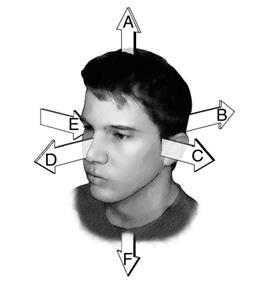
ANSWER: 1. F; 2. C; 3. A; 4. B; 5. E; 6. D
2. Match each letter to the correct location on the figure.
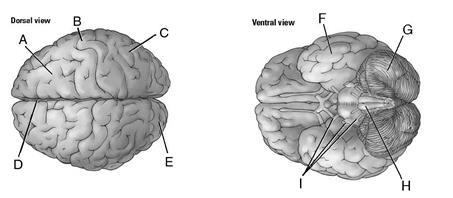
3. Locate the structures on the figure.
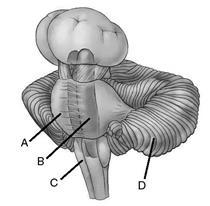
Chapter 02: Diagram
4. Label the brain structures on the figure.
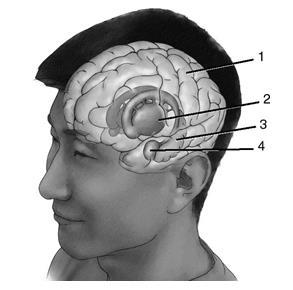
ANSWER: 1. neocortex; 2. basal ganglia; 3. hippocampus; 4. amygdala
5. Match each letter to the correct brain structure.
